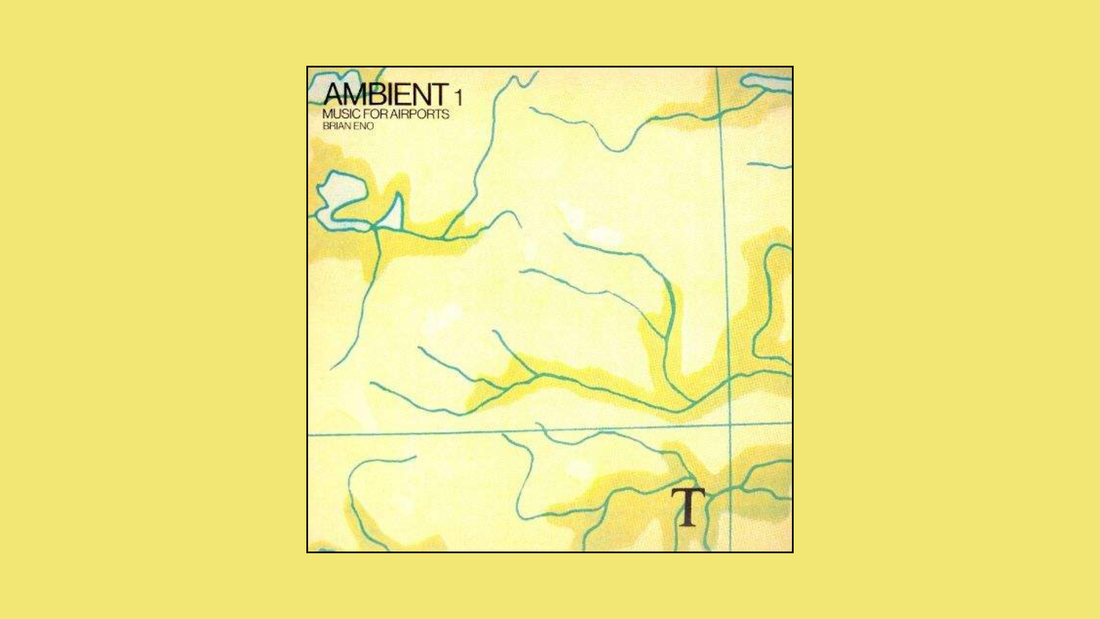
Brian Eno – Ambient 1: Music for Airports (1978)
By Rafi Mercer
The title alone is disarming. Music for Airports. At first glance it seems utilitarian, almost banal — a soundtrack for waiting rooms, an accompaniment to transit. But in 1978, when Brian Eno released this record, he was not designing wallpaper. He was attempting something far more radical: to reshape the very act of listening, to propose that music could be as much architecture as art, as much environment as expression. Ambient 1: Music for Airports is less an album than a proposition: that sound can create space, alter time, and invite us into a state of attention different from the one demanded by songs or symphonies.
The genesis of the project is often told as anecdote. Eno, recovering from an accident, found himself too weak to adjust the volume of a record a friend had put on. Lying there, he heard the music mingling with the sounds of the room — rain, traffic, faint conversation — and realised that listening need not be foregrounded. Music could be present without insistence, a tint to the atmosphere rather than a narrative unfolding. Out of that moment came his definition of ambient music: “to induce calm and a space to think.”
Yet Music for Airports is no background noise. Its power lies in its balance of presence and absence, its ability to be overlooked yet to reward the most focused listening. It is constructed with care as deliberate as any symphony. Four pieces, two per side, each built from tape loops of varying length, allowed to overlap and interact. The loops never align neatly. Patterns emerge, shift, dissolve. It is music composed by system as much as by hand, chance elevated to method.
“1/1,” the opening track, is the most recognisable: Robert Wyatt’s piano, fragmentary and tender, repeating phrases that never quite resolve. Against this, other loops drift in and out — a motif returning minutes later slightly altered, a chord sustained longer than expected. The effect is like light falling across water: familiar, constant, yet never the same twice.
“2/1” introduces voices, wordless and ethereal, layered into long tones that overlap like stained glass colours. The voices never become choir, never coalesce into harmony. They remain fragments, breath and vibration suspended. “2/2” continues this approach, with more complex overlays, until the texture becomes choral architecture without text. These are not songs to be sung; they are spaces to be entered.
The closing “1/2” returns to piano, slower, darker, more meditative. Notes hang like questions, loops brush against each other with deliberate irregularity. The side ends not with closure but with continuation, as if the music might simply extend forever beyond the limits of the record.
The choice of airports as subject was provocative. Airports are liminal zones, spaces of anxiety, delay, and transition. By proposing music for them, Eno was not suggesting distraction but transformation. He imagined music that could make such spaces bearable, perhaps even beautiful. In doing so he redefined the function of music itself. No longer merely art for the concert hall or entertainment for the club, music could be environment, architecture, balm.
Critics at the time were divided. Some dismissed it as pretentious minimalism, others as a revelation. But over decades the record’s influence has grown. It seeded not only the genre of ambient music but also practices in sound art, installation, even therapeutic design. Hospitals have used it. Galleries have installed it. Countless musicians have drawn from it. Without Music for Airports, the language of electronic music in the late twentieth century would look very different.
To hear it now, in an age of saturation and noise, is to feel its clarity anew. It does not compete. It does not shout. It creates a space where attention can soften, where thought can stretch. Its repetition is not mechanical but organic, closer to breathing or waves. Unlike functional background music, it does not numb. It sharpens awareness of the room itself — the hum of electricity, the shuffle of feet, the passage of time. In that sense, it is not escape but engagement.
The record also reveals Eno’s gift for paradox. It is impersonal in construction — loops and systems, chance interactions — yet deeply intimate in effect. It is minimalist in material but maximal in implication. It seems static, yet it is always changing. It can be ignored, yet it rewards deep immersion. Few works hold such contradictions in such equilibrium.
On vinyl, the experience is especially striking. The side breaks force attention to duration. You cannot let the record run infinitely; you must flip it, re-engage, acknowledge time. The faint crackle of surface noise only enhances the effect, another layer of texture merging with the loops. The imperfections of playback become part of the composition, proof of Eno’s claim that ambient music should fold environment into itself.
Music for Airports is not dramatic, not narrative, not emotional in the conventional sense. Its beauty lies in restraint, in patience, in the dignity of slowness. It asks nothing more than presence. And in return, it offers a space — small, fragile, but transformative.
More than forty years on, the record continues to shape not only how we listen but why we listen. It reminds us that music can be more than entertainment, more than expression. It can be environment, architecture, atmosphere. It can be a room we enter, a pause in time, a clearing in the noise.
Brian Eno’s Ambient 1 remains a guidebook for deep listening. It teaches us that music need not demand to matter, that sound can be as important in its absence as in its presence, and that sometimes the greatest gift an artist can offer is not to fill space but to open it.
Rafi Mercer writes about the spaces where music matters. For more stories from Tracks & Tales, subscribe, or click here to read more.














